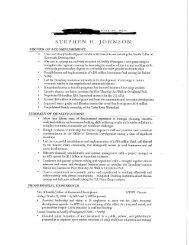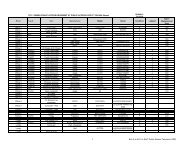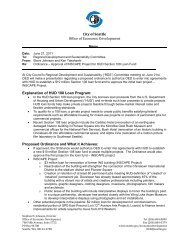2013 Water System Plan, Volume II - Seattle City Clerk's Office - City ...
2013 Water System Plan, Volume II - Seattle City Clerk's Office - City ...
2013 Water System Plan, Volume II - Seattle City Clerk's Office - City ...
You also want an ePaper? Increase the reach of your titles
YUMPU automatically turns print PDFs into web optimized ePapers that Google loves.
If possible, in the center of the storage cell. (Center point sample line installation<br />
may require adding a small support structure to keep the lines from breaking.) The<br />
in-tank sample lines can be used to collect coliform samples after tank disinfection.<br />
If the extent of the horizontal footprint of the storage cell is large relative to the<br />
vertical height, add one or two additional locations across the cell in addition to the<br />
center point.<br />
Sample ports should be easily accessible without the need to open hatches to the storage cell.<br />
Where practicable, the pipes from all sample ports should terminate at a single sampling station<br />
within a lockable cabinet at or near ground level outside the storage cell or within the valve<br />
chamber.<br />
5.9.11 Disinfection and Dechlorination<br />
SPU uses portable ascorbic acid dechlorination units for all dechlorination operations. The draindown<br />
pipe from each storage cell must have a liquid chemical injection station for direct<br />
injection of ascorbic acid.<br />
5.9.11.1 Booster Disinfection<br />
Historically, SPU water storage facilities have received booster disinfection (chlorination).<br />
Booster chlorination may need to be considered for some existing storage facility sites should<br />
chlorine residual maintenance become a problem or a potential problem. Booster chlorination<br />
should be incorporated for new storage facilities located near the periphery of the distribution<br />
system where water demands may be initially low.<br />
The following are major design considerations for booster chlorination at storage facilities:<br />
Footprint space for the chlorination storage and feed system facility<br />
Access and security for the chlorination facility<br />
Injection point(s) for the chlorine<br />
Post-treatment chlorine residual monitoring equipment and sampling points<br />
Point of diversion of potable water for the chlorine feed system<br />
Type of chlorination system: liquid commercial strength (12.5%) hypochlorite or onsite<br />
generation of hypochlorite. Gaseous chlorination systems must not be used.<br />
5.9.11.2 Emergency Disinfection<br />
Regardless of whether provisions are installed for booster chlorination, provide for facilities to<br />
apply emergency chlorination to each storage cell, to include the following:<br />
Hatches on top of each storage cell that can be used to introduce chlorine<br />
Sample withdrawal points from within the storage cell and on the outlet of the cell<br />
to measure chlorine residua.<br />
Minimum of two valves between the storage cell and the distribution system that<br />
can be closed during disinfection<br />
5-62 SPU Design Standards and Guidelines
















